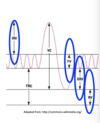Respiratory Physiology W6 Flashcards
boyle’s law
applies to gasses involves volume and pressure - inversely applied as air molecular get closer together, they exert a greater amount of pressure on whatever is containing them i.e. volume decrease = pressure increase and vice versa

fluid mechanics
fluids and gases will flow from areas of greater pressure to aread of lessure pressure until equilibrium is obtained
pressure in respiration
pulmonary pressure - within lungs
atmospheric pressure - outside of the body
resting volume - pulmonary and atmospheric pressure are equivalent
boyles law + fluid mechanics in the lungs
as lungs are expanded the air pressure in the alveoli decreases - air flows from outside the body to inside the lungs
as lungs are contracted the air pressure in the alveoli increases - air flows from within the lungs to outside the body
inspiration
lung expansion - rib cage expansion external intercostals, diaphragm contraction, pleural linkage, expands alveoli in lungs, creates -ve pressure in the lungs, air flows into area of -ve pressure
humans are -ve pressure breathers
expiration
contraction of the ribcage and subsequently alveoli results from 4 passive forces
- elastic recoil, stretched lung tissue
- torque, rotated ribs
- intraabdominal pressure, contracted diaphragm
- gravity, on ribs
pulmonary pressure is greater than atmospheric so passive forces are all that is required for most expiration
lung volumes
resting volume between breaths - lungs are only 40% of maximum capacity
tidal volume - typical volume of air exchanged during complete respiratory cycle
inspiratory and expiratory reserve volume - the air beyond the tidal volume that takes you to full or empty during a forced inhale/exhale
residual volume - the air that is left in the lungs after forcefully exhaling, prevents lung collapse

Lung capacities
inspiratory capacity = TV + IRV, amount of air that can be maximally inhaled
functional residual capacity = ERV + RV, amount of air in the lungs at resting expiration
vital capacity = IRV + TV + ERV, amount of air that can be forcibly exhaled after a forcible inhale, important for speech production
total lung capacity = IRV + TV + ERV + RV, combination of all lung volumes

rest breathing
also known as tidal breathing or quiet breathing, vegetative breathing
12 cycles per minute
speech breathing
we speak on exhalation so the expiratory phase needs to be prolonged
greater intake of air compared to rest breathing
vocal cord resistance to prolong airflow
oral cavity resistance to prolong airflow
crossover of inspiratory muscles into exhalation
phonation
introduction of the phonatory system into the flow of air
air used to adduct vocal folds
occurs on exhalation
continuous phonation
sustained voice production with little variation ahhhhhh
likely acccesses IRV and ERV therefore secondary inspiratory muscles also
must maintain subglottic pressure, subglottic pressure is measured at the vocal folds, done through contraction of expiratory rib cage and abdominal muscles
conversational speech
varied pitch, intensity, and quality
phonation required to turn on and off, 9 of 24 consonant sounds are voiceless
dont use a large proportion of IRV or ERV, lung volume remains mid range throughout
quick and powerful inspirations required and expiratory bursts for intonation, stress and intensity, abdominal and chest wall muscles active immediately on expiration, ready to drive expiration
respiratory cycles
tidal breathing - inspiration 40%, expiration 60%
- uses only approximately 50% of vital capacity
- 40% resting lung volume + 10%
phonatory respiration - inspiration 10%, expiration 90%
-uses beteween 60% (into IRV) - 30% (into ERV) VC



